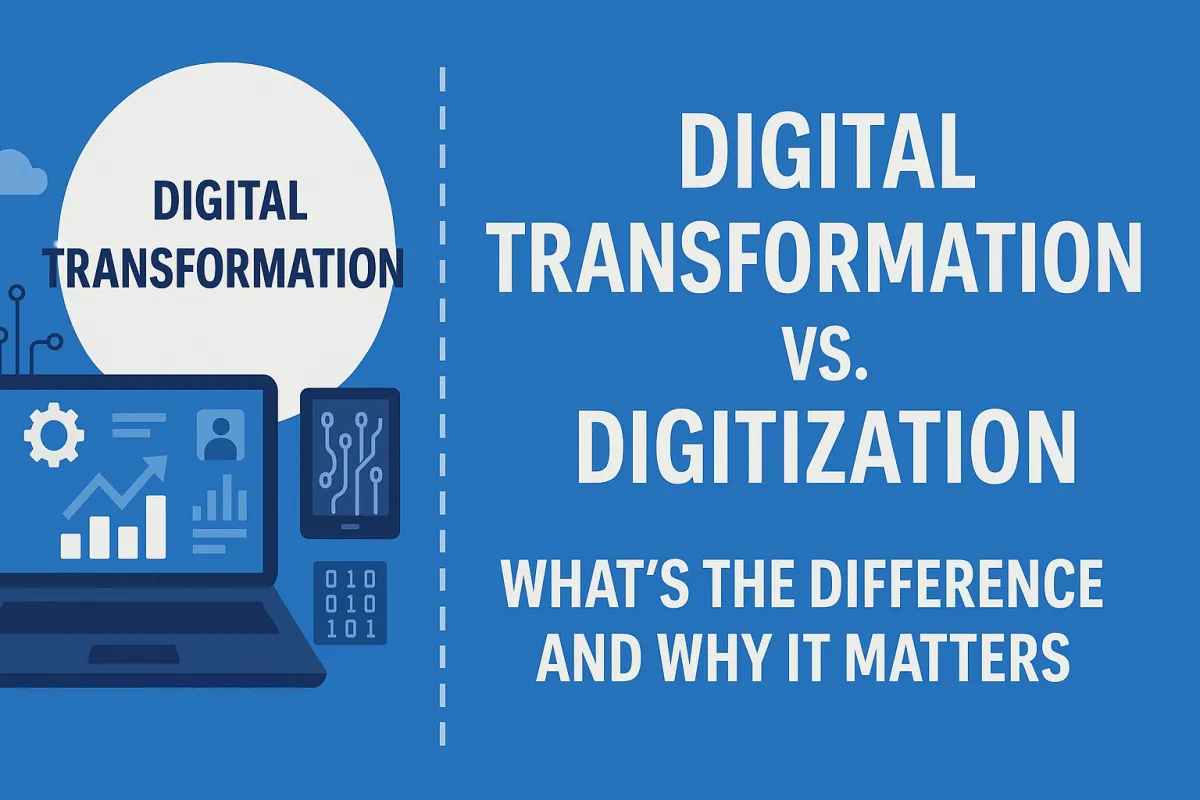
From Digital Copies to Digital Change
When businesses talk about “going digital,” they often use terms like digitization and digital transformation interchangeably. But they are not the same. Understanding the difference is crucial, because many transformation efforts fail when people confuse the two.
Let’s unpack both, explain how they relate, and show why this distinction matters for any business—especially service businesses.
What Is Digitization?
Digitization is the process of converting something from a physical or analog form into a digital form.
For example, taking paper documents and scanning them to PDFs, or converting handwritten notes into a digital file.
It could also include turning recorded audio, photos, or charts into digital versions.
Digitization is mostly about creating a digital copy or version of something that already exists, so it can be stored, shared, and accessed more easily.
This is the foundational step—without digitization, you can’t then build processes or systems using digital data.
What Is Digital Transformation?
Digital transformation is much broader. It’s not just converting stuff to digital—it’s rethinking how your whole business works using digital tools and technology.
It means using technology to change how you deliver service, how you reach customers, how your internal processes run, and even how your business model works.
It often involves cultural, organizational, and strategic changes—not just tools.
So digital transformation might include:
Using cloud software so your team can work from anywhere
Automating workflows so tasks trigger automatically
Adding analytics to understand customer behavior
Adopting digital communications, marketing, service channels
Digital transformation uses the results of digitization (digital data) and combines it with technology, strategy, and change to reshape how the business functions as a whole.
How They Relate
Digitization is a building block. It’s the first step. Once you have data in digital form, you can:
Digitalize (or digitalization): start using that data to improve existing processes
Then transform: use digital tools and strategy to overhaul or evolve your business
In many frameworks, digitization → digitalization → digital transformation are seen as stages.
If you try to do a full transformation without having good digital data or processes, you’ll struggle because you lack the foundation.
Why the Distinction Matters
If businesses don’t understand the difference, they often make mistakes:
They treat digitization (scanning docs) as “being digital,” but then expect magical transformation without changing processes or culture.
They invest in flashy tools without cleaning data or integrating systems, which leads to chaos or failure.
They try to change everything at once instead of building logically from digitization to transformation.
Knowing the distinction helps you plan wisely, prioritize, and avoid wasted efforts.
Key Benefits When Done Right
When you properly move from digitization to transformation, you gain:
Efficiency & time savings: less manual work, faster processes
Better decisions: use data and analytics instead of guesswork
Scalability: technology helps you grow without scaling costs linearly
Better customer experience: faster, more personalized service
Flexibility & innovation: you can try new services, adjust quickly
A Simple Example
Let’s say you run a home services business (cleaning, plumbing, etc.).
Digitization step: you scan customer records, invoices, and past work orders into digital files instead of paper.
Digitalization step: you build a system so when a customer books you, their past data shows up, and tasks or reminders trigger automatically.
Transformation step: you use mobile apps for field staff, integrate everything in the cloud, use analytics to predict demand, and offer subscription services or automated maintenance plans.
Each step builds on the prior one.
If you’d like help mapping out how your business can move from digitization to full transformation, contact CLR Solutions.
5 FAQs
Q1. Can digitization alone solve my problems?
A: It helps, but it won’t fully transform your business. Digitization makes data digital, which is essential. But unless you change processes and adopt new tools, your business won’t shift in big ways. Want to go further than just digitization? Reach out
Q2. Is digital transformation only for big companies?
A: Not at all. Even small or service businesses can transform by starting with small changes—like automating one process or adopting cloud tools. Over time, that builds into bigger transformations. Let’s find simple steps for your business. Contact us
Q3. How do I begin transforming my business?
A: Start by digitizing your core data (customer records, financials). Then pick one important process (like invoices or scheduling) and digitalize it. Use those improvements as building blocks for full transformation. We can help you build that roadmap. Get in touch
Q4. What’s the biggest trap people fall into?
A: They skip steps. They jump into expensive tools or transformation before having clean digital data or efficient processes. This often leads to failure or frustration. Avoid that trap—let us guide you. Contact us
Q5. How long does full digital transformation take?
A: It depends on your business size, complexity, and goals. Some parts (digitization) may take weeks or months. Full transformation might take many months or years. But small wins happen earlier. Let’s estimate a timeline for your business. Let’s talk

